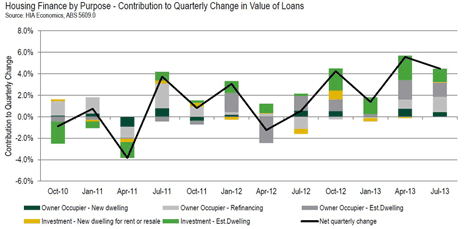Housing borrowing increasing for everyone except first-home buyers: ABS
Total lending on houses has continued to grow steadily according to the Australia Bureau of statistics, but The Real Estate Institute of Australia says first home buyers are missing out.
The number of owner-occupied finance commitments rose by 1.6% – following increases of 2.1% in June and 2.4% in May, in trend terms, according to the ABS.
If refinancing is excluded the increase for July, is 1.5%, in trend terms.
Click to enlargeThe value of investment housing commitments rose by 0.8% in July in trend terms, the 12th consecutive monthly increase.
Every state had increases in owner-occupied finance commitments with the largest increases in the ACT and Queensland, up 2.0% and 1.9% respectively in trend terms.
The purchase of established dwellings is up 1.8% in trend terms, the purchase of new dwellings is up 1.4% in trend terms and the number of commitments for the construction of new dwellings is up 0.2% in trend terms.
But the proportion of first home buyers in the number of owner-occupied housing finance commitments fell to 14.7% compared to 15.1% in June.
“The figure remains persistently low compared to the long-run average proportion of 20.1 per cent despite seven interest rate cuts since November 2011,” says REIA’s Peter Bushby.
“In large part, this drop can be attributed to state governments withdrawing previous levels of support for first home owners buying established dwellings and it is established dwellings that 80% of first home buyers prefer.
“With the proportion of first home buyers remaining consistently below the long term average, this needs to be a high priority issue for the incoming Government.”
Westpac’s Matthew Hassan’s the results are broadly positive save for continued subdued first home buyer activity and a more mixed month for construction-related approvals.
“Stepping back from the monthly detail, finance approvals are starting to show a clear response to low interest rates. The upturn has been much slower to come through than previous cycles and remains of middling strength,” Hassan says.
“It is also showing a much more muted pick up in housing credit (+5.3% per year in July). The implication is that the rise in new lending is being mostly matched by a rise in repayments on outstanding loans.
“Some of that may be a byproduct of low FHB activity but it also likely reflects consumers' aversion to taking on additional debt.”
The Housing Industry Association says the results for construction finance are disappointing with the number of loans for construction fell by 2.1% to be only 1.1% higher than a year earlier.
“This is a good result, but the lack of strong upward momentum for the construction component over 2013 to date is disappointing,” says HIA’s Geordan Murray.
“The aggregate value of lending for housing increased by 4.5% in the July 2013 quarter. There has been strengthening demand from both owner occupiers and investors, which in itself is encouraging, but growth has been driven primarily by lending to those purchasing existing homes.
“The value of lending to owner occupiers for construction and the purchase of new homes increased by 2.5 per cent, while lending to investors purchasing new homes increased by 3.3 per cent in the July quarter of 2013. Despite this, the total increase in lending for new homes only contributed 0.5 percentage points to the quarterly growth.”
